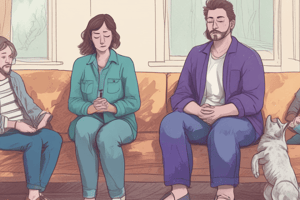Podcast
Questions and Answers
Which of the following is the most accurate definition of abuse in the context of interpersonal relationships?
Which of the following is the most accurate definition of abuse in the context of interpersonal relationships?
- Physical altercations between individuals in a relationship.
- Wrongful use and maltreatment of another person, typically by someone known to the victim. (correct)
- Disagreements and arguments that occur frequently in a relationship.
- Any form of communication that one partner finds offensive.
A patient presents with unexplained physical injuries, agitation, and expresses feelings of self-blame. Which condition should the healthcare provider suspect?
A patient presents with unexplained physical injuries, agitation, and expresses feelings of self-blame. Which condition should the healthcare provider suspect?
- Generalized Anxiety Disorder
- Major Depressive Disorder
- Substance Use Disorder
- Abuse or Violence (correct)
Which of the following is NOT a commonly observed characteristic within violent families?
Which of the following is NOT a commonly observed characteristic within violent families?
- Social isolation.
- Abuse of alcohol and other drugs.
- Equitable distribution of power and control. (correct)
- Intergenerational transmission of violent behavior.
What is the estimated ratio of women to men who experience intimate partner violence?
What is the estimated ratio of women to men who experience intimate partner violence?
Which factor increases the risk of intimate partner violence?
Which factor increases the risk of intimate partner violence?
How does an abuser typically perceive their partner in the context of intimate partner violence?
How does an abuser typically perceive their partner in the context of intimate partner violence?
What behavior might an abuser exhibit when their partner begins to display signs of independence or expresses a desire to leave the relationship?
What behavior might an abuser exhibit when their partner begins to display signs of independence or expresses a desire to leave the relationship?
What is a common characteristic of individuals who are abused?
What is a common characteristic of individuals who are abused?
How does the statistical frequency of intimate partner violence in same-sex relationships compare to that in heterosexual relationships?
How does the statistical frequency of intimate partner violence in same-sex relationships compare to that in heterosexual relationships?
Which statement best describes why victims in same-sex relationships may face unique challenges?
Which statement best describes why victims in same-sex relationships may face unique challenges?
Which phase directly precedes a violent episode in the cycle of abuse and violence?
Which phase directly precedes a violent episode in the cycle of abuse and violence?
Why might victims of intimate partner violence not seek direct help for the abuse?
Why might victims of intimate partner violence not seek direct help for the abuse?
Which intervention is NOT typically part of the immediate treatment plan for someone experiencing intimate partner violence?
Which intervention is NOT typically part of the immediate treatment plan for someone experiencing intimate partner violence?
What is the most frequently reported type of incest in child abuse cases?
What is the most frequently reported type of incest in child abuse cases?
Which factor is most indicative of a parent who is likely to be abusive?
Which factor is most indicative of a parent who is likely to be abusive?
What might raise suspicion of child abuse rather than accidental injury?
What might raise suspicion of child abuse rather than accidental injury?
A nurse suspects child abuse but lacks definitive proof. What is the appropriate course of action?
A nurse suspects child abuse but lacks definitive proof. What is the appropriate course of action?
What is the underlying belief of abusers who experienced abuse in their childhood?
What is the underlying belief of abusers who experienced abuse in their childhood?
Which of the following is the most intricate and challenging aspect for a healthcare provider in discerning potential intimate partner violence (IPV) during routine patient interactions?
Which of the following is the most intricate and challenging aspect for a healthcare provider in discerning potential intimate partner violence (IPV) during routine patient interactions?
A researcher aims to evaluate the long-term efficacy and ethical considerations surrounding mandatory reporting laws in suspected child abuse cases across different socioeconomic strata. Which methodological approach would provide the most nuanced and comprehensive understanding?
A researcher aims to evaluate the long-term efficacy and ethical considerations surrounding mandatory reporting laws in suspected child abuse cases across different socioeconomic strata. Which methodological approach would provide the most nuanced and comprehensive understanding?
In cases of suspected child abuse, what is the nurse's primary responsibility?
In cases of suspected child abuse, what is the nurse's primary responsibility?
What is the priority when addressing child abuse?
What is the priority when addressing child abuse?
Which of the following is a common form of elder abuse?
Which of the following is a common form of elder abuse?
Which factor increases the likelihood of elder abuse?
Which factor increases the likelihood of elder abuse?
Why are older adults often reluctant to report abuse?
Why are older adults often reluctant to report abuse?
Which assessment finding might raise suspicion of elder abuse?
Which assessment finding might raise suspicion of elder abuse?
According to the content, what constitutes rape and sexual assault?
According to the content, what constitutes rape and sexual assault?
Which statement is accurate regarding the location of rape and sexual assault incidents?
Which statement is accurate regarding the location of rape and sexual assault incidents?
What is a crucial element in understanding the prevalence of rape and sexual assault?
What is a crucial element in understanding the prevalence of rape and sexual assault?
A nurse suspects caregiver neglect of an older adult but lacks definitive proof. The older adult refuses to report the suspected abuse, fearing the loss of their primary source of care. What is the most ethical course of action for the nurse?
A nurse suspects caregiver neglect of an older adult but lacks definitive proof. The older adult refuses to report the suspected abuse, fearing the loss of their primary source of care. What is the most ethical course of action for the nurse?
Flashcards
Abuse
Abuse
Wrongful use and maltreatment of another person.
Common abuse victims
Common abuse victims
Partners, children, older adults, or parents.
Effects of abuse
Effects of abuse
Physical injuries and psychological trauma.
Behavioral signs of abuse
Behavioral signs of abuse
Signup and view all the flashcards
Family Violence
Family Violence
Signup and view all the flashcards
Characteristics of violent families
Characteristics of violent families
Signup and view all the flashcards
Intimate Partner Violence (IPV)
Intimate Partner Violence (IPV)
Signup and view all the flashcards
IPV Statistics (Women)
IPV Statistics (Women)
Signup and view all the flashcards
Abuser (Male) Characteristics
Abuser (Male) Characteristics
Signup and view all the flashcards
Abused (Female) Characteristics
Abused (Female) Characteristics
Signup and view all the flashcards
Child Abuse Reporting
Child Abuse Reporting
Signup and view all the flashcards
Reporting Threshold
Reporting Threshold
Signup and view all the flashcards
Elder Abuse Types
Elder Abuse Types
Signup and view all the flashcards
Risk Factor: Chronic Illness
Risk Factor: Chronic Illness
Signup and view all the flashcards
Common Abusers
Common Abusers
Signup and view all the flashcards
Reasons for Non-Reporting
Reasons for Non-Reporting
Signup and view all the flashcards
Elder Abuse Signs: Assessment
Elder Abuse Signs: Assessment
Signup and view all the flashcards
Elder Abuse Interventions
Elder Abuse Interventions
Signup and view all the flashcards
Rape Definition
Rape Definition
Signup and view all the flashcards
Rape: Underreporting
Rape: Underreporting
Signup and view all the flashcards
Cycle of Abuse
Cycle of Abuse
Signup and view all the flashcards
IP Violence: Help-Seeking
IP Violence: Help-Seeking
Signup and view all the flashcards
IP Violence: Interventions
IP Violence: Interventions
Signup and view all the flashcards
Child Abuse
Child Abuse
Signup and view all the flashcards
Child Abuse: Incest
Child Abuse: Incest
Signup and view all the flashcards
Abusive Parents Traits
Abusive Parents Traits
Signup and view all the flashcards
Detecting Child Abuse
Detecting Child Abuse
Signup and view all the flashcards
Warning Signs of Abuse
Warning Signs of Abuse
Signup and view all the flashcards
Child Abuse Injuries
Child Abuse Injuries
Signup and view all the flashcards
Nurse's Role: Reporting
Nurse's Role: Reporting
Signup and view all the flashcards
Study Notes
- Abuse is the wrongful use and maltreatment of another person, typically by someone the victim knows
- Victims of abuse can include partners, children, or older adults/parents
Clinical Picture of Abuse and Violence
- Physical and psychological injuries are common in abuse victims
- Abuse victims may exhibit agitation or withdrawal
- Victims often internalize blame for the abuse
- Low self-esteem and feelings of being unlovable are common, which can lead to missing school
- Abuse can lead to depression and suicidal behaviors
Characteristics of Violent Families
- Family violence can manifest as child abuse, elder abuse, or marital rape
- Common characteristics of violent families include social isolation, abuse of power and control (physical, economic, social)
- Alcohol and drug abuse, as well as intergenerational transmission of violence, are also indicators
Intimate Partner Violence
- Involves mistreatment or misuse of one person by another within an emotionally intimate relationship
- Women experience higher rates of intimate partner violence at 1 in 5, versus men who experience it at 1 in 12
- Rates of intimate partner violence increase during pregnancy
- Occurs in same-sex relationships with similar statistical frequency, but victims may have fewer protections
- Abusers view their partners as possessions
- Abusers become increasingly violent when their partner shows signs of independence
- Abusers tend to have feelings of inadequacy and low self-esteem
- Abusers gain a boost in self-esteem through abuse
Dynamics of Abuse and Violence
- Cycle: violent episode, honeymoon period, tension-building phase, then another violent episode
- Victims don't often seek direct help for abuse, but may seek treatment for other conditions
Questions to Assess Safety
- Are you concerned about your safety?
- Do you feel safe in your relationship?
- Do you ever feel threatened?
- Are your children safe?
- Are family and friends concerned for your safety?
- If you feel threatened or unsafe, is there someone you can call?
- Do you have a safe place to go?
- Do you have a plan if your situation suddenly becomes unsafe?
Treatment and Interventions for Abuse and Violence
- Laws related to domestic violence and arrest
- Restraining orders/protection orders can provide legal protection
- Shelters can provide safe housing
- Psychotherapy/counseling, both individual and group therapy can address abuse
- Treatment for posttraumatic stress disorder (PTSD) with cognitive behavioral therapy
Child Abuse
- Intentional injury of a child, including: Physical abuse or injuries, Neglect (physical, emotional, educational necessities), Psychological abuse, Abandonment, Sexual assault or intrusion, and Overt torture or maiming
- Most reported cases involve father-daughter incest; mother-son incest is much less frequent
- Parents who abuse their child may show: minimal parenting knowledge and skills, emotional immaturity, neediness, incapacity to meet their own needs, frequently children are seen as properties, intergenerational transmission
- Look out for: Serious injuries without history of trauma (fractures or burns) that the parents cannot explain, Inconsistency in story of child and parent, Unusual injuries for the child's age (ex. 2 month old with fracture of femur), and Different stages of healing of injuries
- Nurses do not have to decide if abuse has occurred, reporting suspected child abuse with accurate documentation
- Child's safety and well-being is a priority, involve removing patient from home
- Psychiatric evaluation, and Therapy may be indicated over a long time
Elder Abuse
- Maltreatment of older adults, including: Physical, sexual, psychological abuse, Neglect or self-neglect, Financial exploitation, and Denial of adequate medical treatment
- Abuse is likely when an older adult has multiple conditions
- Abuser – caregiver (usually family member) mostly spouse
- Older adults are reluctant to report to protect family members, and because they fear losing support
- Look out for: Frequent, unexplained injuries, Malnourishment, Unusual activity in bank accounts, Poor personal hygiene, Failure to keep on medical appointments, and Inability to manage ADL
- Provide caregiver stress releif, additional reasources, and possible removal of older adult or caregiver
Rape and Sexual Assault
- It is the perpetration of the act of sexual intercourse with person against their will and without consent
- Will overcome by force, fear of force, drugs, intoxicants
- Only slight penetration is necessary for rape
- rape is committed by acquaintances, married people, people of same sex, or strangers
- it is most commonly done by met people
- Rape is a highly underreported crime
- Most commonly occurs in victim's neighborhood, often inside or near home
- Most rapes are premeditated
- Male rape is significantly underacknowledged and underreported
Dynamics of Rape
- Women were historically objects of aggression
- Primary motivation of victim is to stay alive
- Severe physical and psychological trauma
Assessment for Rape
- Physical examination to preserve evidence is needed
- Description of what happened need to be gathered
- Look out for Rape kits, and rape protocols
- the treatment and intervention should involve: Immediate support, Gice control back to victim, prophylactic treatment for sexually transmitted diseases, pregnancy, Counseling, and Supportive therapy
Community Violence
- Includes School violence (homicides, shootings), and Bullying with Ostracism, and Hazing
- Effects children, and young adults
- Violence on a larger scale (e.g., terrorism), PTSD and depression
Studying That Suits You
Use AI to generate personalized quizzes and flashcards to suit your learning preferences.



